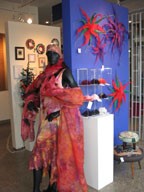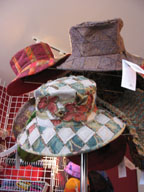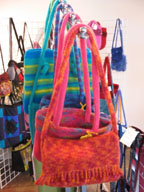Christmas, Consumerism and Artistic Creation
Alex Starace investigates the intersection of holiday, the urge to buy, and the urge to make. What can it tell us (other than the obvious thing, which is that human beings are too damn busy)?






The litany of complaints against Christmastime (crass commercialism, encouraged over-consumption, and manipulated memories) has itself become a cliché. The whole season – with its frenzied shopping, frenzied critics, and frenzied families – lends itself to one giant, dismissive eye-roll: many of us enjoy spending time with our families, getting a few days off from work and looking at the Christmas lights, but, Go to the mall? Participate in holiday office parties? Watch Rudolph the Red-Nosed Reindeer? . . . Maybe next year, hopefully never.
Such an attitude, however satisfying, can be extremely reductive: the annual apotheosis of consumerism, capitalism, and marketing can teach us a lot about ourselves. In the world of art criticism, for instance, the best time to see the interaction of money and art, popular consumption and aesthetics, and materialism and idealism, is arguably mid-December. With this spirit in mind, I went to the Holiday Sale at the Textile Center in Minneapolis.
The center, billed as “a national center for fiber art,” is the hub of a strong community of quilters, knitters, and seamstresses, and, whether or not the Holiday Sale turned out to be worthwhile, the Textile Center is clearly important to those involved – people at the center feel that what they do is art, not hobby or craft. Theoretically, then, there is no reason (other than some sort of snobby hang-up on my part) that the Holiday Sale couldn’t present legitimate art: it’s a juried exhibition held in the Joan Mondale Gallery, a space that regularly has non-holiday-sale exhibits – the fact that the stuff is for sale (and mostly Christmas-themed) shouldn’t automatically disqualify it from thoughtful consideration.
The first thing I noticed, though, is that each piece in the Holiday Sale has a business card attached to it (Miller Upholstering, Had Matter Hats, Kelly Marshall, My Fabulous Fibers, etc), along with a price tag, and a description of how to care for and wash the item. There’s a wide range of objects – from upholstered stools to hanging rugs to Christmas ornaments to everyday-use hats – and although the holiday theme is often followed, a significant portion of the objects are not at all Christmas-related. The stuff is hung on racks, or on the wall, and patrons can touch and peruse at their leisure; attending the show (sale) feels like, well, walking through a store and checking out the merchandise.
Throughout, the pieces are common and pedestrian, marking them as commodities – not art. There’s nothing about, for example, a Margaret Mousley purse that distinctly distinguishes it from a purse one could buy at Target or Bloomingdale’s (or from a purse made by another artisan at the Sale) – sure, Mousley’s purses are handmade and her website proclaims: “These Limited Edition bags are each a work of art and can’t be replaced,” but she seems a bit too eager in the assertion – when looking at the bags, they’re certainly nice, but had I not been informed that they were irreplaceable, I would have mistaken them for everyday ‘fancy’ handbags. In other words, it seems that a lot of what causes a Mousley handbag to be valuable is that it’s called ‘art,’ and ‘one-of-a-kind,’ and ‘handmade,’ and ‘irreplaceable’ – its status as ‘art’ is itself a heavily marketed commodity.
And so the focus, then, is on filling out a list of qualifications: Limited edition? Check. Appealing to those with an interest in ‘wearing’ some art? Check. Quirky-but-still-functional? Check. One-of-a-kind? Check. Branded prominently with the name of an artist? Check. Clearly derivative of recognized artistic forms? Check. Difficult (or impossible) to find in large retail stores? Check. . . . and voila! The Mousley handbag can be referred to as ‘art’ and be sold to eager consumers. No matter that the handbag does none of what artists cherish about art: it doesn’t challenge the way its consumers think about the world, it gives no expression to complicated ideas, provokes no original thought and, visually, provides no surprise or innovation. In short, there’s no “a-ha!” moment, no pondering, no knock-your-socks-off beauty . . . A Mousley handbag is, of all things, just a nice handbag and the fact that she refers to it otherwise doesn’t change this.
For a contrast, I attended an exhibit – “Fa La La La La: The Peter Norton Family Christmas Editions “– at the Weisman Art Museum. The premise of the show is this: every year since 1988 the Norton family has commissioned a prominent contemporary artist to create a ‘multiple’ (an artwork that can be mass-produced) and then that artwork has been duplicated by the thousands and sent across the world to the friends of the Norton family in place of a Christmas card. Most of the works have little to nothing to do with Christmas – among the most impressive of these is Robert Lazzarini’s Teacup (2003), which is, for lack of a better way to describe it, a surrealist teacup. It’s three-dimensional, functional (presumably), and yet, somehow melted – warped as if it were in a Dali painting – and is such a bizarre curio that one can’t help but ogle. Equally bizarre is Vik Muniz’s Untitled Plate (1999), which has, glazed-on, the image of a screaming spaghetti-and-marinara-sauce Medusa. More complicated is Yasumasa Morimura’s Ambiguous Beauty/Aimai-no-bi (1995), which is a traditional Japanese fan featuring a transgender nude: Morimura himself is made-up (complete with false breasts) to appear as a white American pin-up girl coquettishly gazing at the viewer. The work questions normative gender and race roles, while Alice Gaskell’s Untitled (2001) evokes longing, mythology, and fear in a three-dimensional piece that allows the viewer to look down the levels of a spiraling well and see a woman below, swimming, alone and splashing, as hands from above reach out to her.
What differentiates the “Fa La La La La” exhibit from the Holiday Sale isn’t that there are prices attached at one and not the other (I’m sure the Norton Christmas Editions would sell very well) but that the aspirations of the artists are entirely different – one group of artists is attempting to make money as artists and while the other is attempting to make art as artists. If this distinction between commerce-driven and art-driven art sounds rudimentary (and one would be reasonable to point out that handbags and hats and rugs are quite a bit different from commissioned artwork) it’s not quite as clear to the general public as it might seem.
In the Mall of America in Bloomington, Minnesota, there exists the Thomas Kinkade Gallery (TKG). The gallery (unlike the Textile Center) presents only ‘fine’ art – art that has little ostensible function, other than being art – and is, therefore, more readily comparable to the “Fa La La La La” exhibition. What’s currently on display at the TKG (and what’s always on display) is the work of Thomas Kinkade, an enterprising painter in the tradition of late-night-television limited-edition collectable plates. The gallery is full of atmosphere: there’s a fake fireplace and tons of mahogany to provide a backdrop for the paintings, which are an amalgamation of Bierstadt, Rockwell, and French Impressionism. The result is overwrought schlocky sentimentality with titles such as Living Waters: Golfer’s Paradise, Hole One (homey Rockwellian golf course with Bierstadt’s towering cliffs and blindingly nacreous clouds in the middle and far distance), Church of the Wayfarer (a comfortingly benign church tucked amongst trees and blooming flowers), and Boston Celebration (which was painted shortly after the Patriots won the 2005 Super Bowl and yet, somehow, manages to look extremely Parisian circa 1910.)
That Kinkade is a shrewd hack is obvious – what is perhaps less obvious is how well his paintings sell – he does, after all, have a store in the MOA. Upon talking to a clerk, I learned that Kinkade doesn’t sell original paintings: he has them reproduced – usually through a lithograph technique – and then has the reproductions numbered and signed. The clerk explained: “These are ‘investment value’ pieces – people collect them to make money . . . In fact, Kinkade is the most collected artist in the America today.” He went on to describe how certain pieces are released in only very limited editions, while others receive wider distribution, and still others, after being reproduced (these are the Studio Editions) are then personally signed by the artist himself. All told, Kinkade does a good job of manipulating his prices – the average reproduction (frame included) sells for about a thousand dollars.
Kinkade’s work demonstrates the pitfalls of joining art too closely with consumerism: his work fails artistically because he paints (quite well) using outdated and conventional styles and techniques – his paintings are empty shells of what was once original expression. And yet this is exactly why he’s so popular: he uses forms that his consumers are already extremely familiar and comfortable with – in fact, in order to appease them (and to make buckets of money) he has to try to be unoriginal. In other words, for all the popular, consumable, worthwhile, and innovative works of art – such as the television show South Park (which has as its aim not simply ‘being’ art, but being funny, satirical and politically aware) – there are many, many more purchaseables (go to any craft store in a tourist-trap town) that are insipid examples of art-cum-collectable – pieces of art that aren’t art, but instead are knick-knacks (or collectible paintings) thought of art merely because they have no other possible function – because they fit into tired categories of what is considered ‘artistic.’ Furthermore, Christmastime (as I learned roaming the MOA) creates the biggest market for these purchaseables if only because it provides so many ready-made motifs (Santa Claus, reindeers, Christmas trees, presents, sleighs, cookies, sleighbells, snowmen, etc) for uninspired ‘artists’ to use as a crutch and for uncreative consumers to purchase and put on their mantelpiece.
Much like consumerism, Christmas can be (to add to the list of its boogeyman qualities) a great stunting of artistic creativity and innovation, though it (again, much like consumerism) doesn’t have to be – exhibits like “Fa La La La La” demonstrate that fresh ideas can arise out of old forms (in the case of “Fa La La La La,” the old form being the Christmas card). And, really, the forms themselves are not to blame – art has to spring from somewhere. Rather, it’s the ease with which consumers, artists, the general public – fill in what you like – allow themselves to slip into boring motifs, simple collecting, and little intellectual thought – to avoid improvement upon already-used ideas merely because the already-used ideas are already there. . . . Perhaps, then, it’s not Christmas and consumerism to blame, but us – we, after all, are the ones who perpetuate mediocre art by purchasing the very art-cum-collectable we decry.